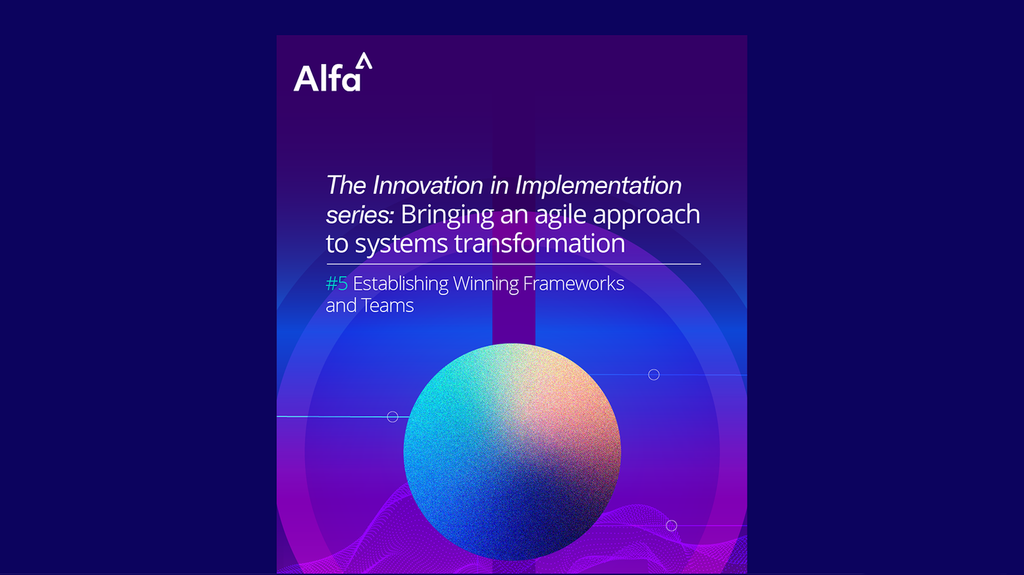Thought Leadership
Sponsored by Alfa
Establishing winning frameworks and teams for successful technology transformation
TowHaul Corporation is the leading manufacturer of off-road lowboys specifically designed for the open-pit mining industry
Main image credit:
One of the most important factors in a successful technology transformation is the people. That's not just about attracting and retaining talent, but spans a wide range of factors - including how to build strong teams, how to ensure clear and effective communication, and how to overcome challenge and adversity.
Concluding the Innovation in Implementation insights series, this new paper, Establishing Winning Frameworks and Teams, offers insight into how to coalesce strong, motivated teams with the latest innovations, to deliver successful change with reduced risk. It explores the role of leadership and governance, how to establish the right project resources and communication between them, and the qualities that partners should bring to the table.
In today’s rapidly evolving technological landscape, finance providers are continually challenged to adapt and embrace change. Alfa’s Innovation in Implementation series has revealed cutting-edge strategies that can significantly reduce the inherent risks of such transformations, from fundamental mindset shifts to harnessing the latest SaaS innovations. However, as Alfa highlights in this piece, one of the most pivotal elements of a successful technology transformation is the human one.
Leadership teams must work together to unify and champion technology and business visions, ensuring new and exciting technology can deliver true business value.
All successful technology projects begin with leadership. The executive team’s clear understanding of and commitment to the value that can be gained from implementing new technology is a key requirement at all stages of the project. This becomes particularly important when facing challenges which, during complex implementations, will inevitably emerge, including limiting scope creep and stretching of resources.

Detailed resourcing approaches can differ from project to project, but the fundamental ingredients for success are balance and commitment: ensure a balance between technology and business, with resources being committed to the project vision without distractions.
Multiple teams must work together to achieve the goal, and communication needs to take place between the project team and the wider company - all backed by a powerful vision communicated by leadership.
For a project to succeed, in addition to building strong, effective teams, communication between them must be clear and efficient.
For a complex project such as an asset finance system replacement, multiple teams must work together to achieve the goal. If those teams are working in silos, an essential flow of both value and communication is lost. The impacts are numerous, including missed requirements, lack of deliverable ownership, and unclear prioritisation - all of which result in delays.
This should be backed by a powerful vision communicated by leadership. By doing so, project context is provided and each individual or team can understand their role in it, as well as the value they are adding.
Vendor requirements should go beyond their product offering, such as a clear understanding of their implementation methodology, and an intention to increase organisational knowledge through application ownership.
Large, complex technology projects will often include external vendors and partners. It is vitally important to capture solution requirements to assess correctly which of those external parties can help deliver success. But there are several requirements that go beyond the product offered by a vendor that are of equal importance, especially when the vendor will form a key part of the project team.
Having a clear understanding of the vendor’s implementation methodology will not only help form a vision for how the replacement project will be carried out, but also help reduce the time and effort establishing that methodology. Choosing a vendor with a strong track record can help provide confidence in the approach and how it could complement any existing organisational methodologies.
Having a clear and committed approach for application ownership should be taken as a positive sign. This not only provides a clear path for reducing long-term, post-implementation costs, but also can boost the chances of project success.
It is also important to review the compatibility of the partner from a cultural perspective. The environmental, social and governance (ESG) credentials of a vendor are becoming an increasingly important aspect of the procurement process. Choosing a partner that shares or complements your fundamental values will provide significant benefits for the day-to-day progression of the project.
In addition to selecting the right partner, the relationship between the project and partner is a key aspect of success. Ultimately, a successful implementation is mutually beneficial, with the cornerstones of this relationship being trust and confidence.

Equally, strong governance is a way of ensuring success as part of the journey. Governance is not just an escalation route for points of failure or difficulty, but a way of embedding overarching principles that stem from the project vision, and can serve as a compass for the project. Having a clear view of roles and responsibilities, and project phasing and planning are key elements of this. Failure to implement a governance structure, or to establish one too late, can result in a rudderless, scattergun approach that results in delays and failure.
It's important to avoid viewing the project through a purely technical lens, and overlooking input from the business. The business should be enfolded as a part of the project, rather than a mere recipient of its outcome.
A common question posed when embarking on a systems replacement project is the optimal resource profile of the team. The answer often depends on the project’s scope and resourcing constraints, but key fundamentals that can provide the foundation for success. For example, avoiding viewing the project through a purely technical lens and ensuring sufficient representation from the business will improve decision making and change management. Not spreading technical resources too widely across a number of initiatives will minimise in delays and rework.
Replacing a core system at the heart of an asset finance business is a complex endeavour. The Alfa Innovation in Implementation insight series has explored various facets of such projects, but the role of people is arguably the most important.
The example and vision set by leadership provides a vital guiding light for the challenging road ahead. Having the right talent to execute that vision, with the right structures in place for clear and regular communication between teams, can provide the basis for success. This is underpinned by selecting the right partner, not just to help with the build effort, but also to draw upon their experience throughout the project.
Alfa has over 30 years of experience building and delivering asset finance software. This ranges from equipment to automotive, low-volume but high-complexity structured financing, to multi-million, homogeneous automotive portfolios. This range of experience has been drawn upon to establish Alfa Delivery, our implementation methodology, which can be adjusted and tailored to meet the needs of clients of all shapes and sizes.
Contact information
Alfa
Moor Place
1 Fore Street Avenue
London EC2Y 9DT
Email: sales@alfasystems.com
Web: www.alfasystems.com